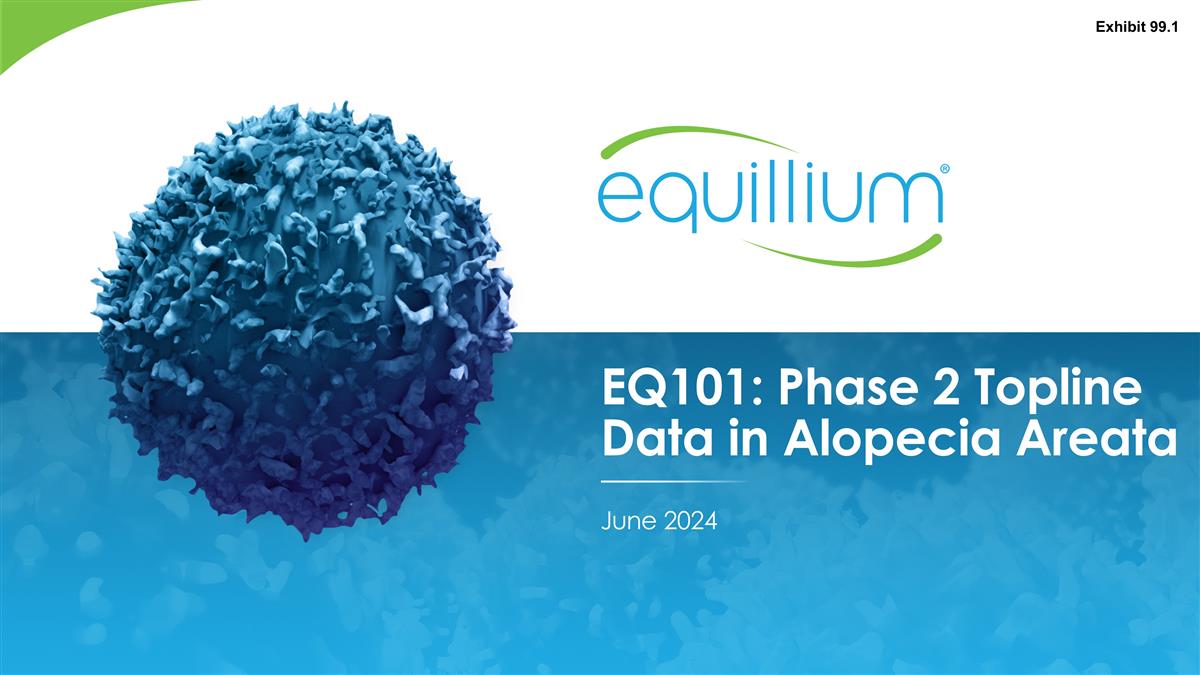
EQ101: Phase 2 Topline Data in Alopecia Areata June 2024 Exhibit 99.1
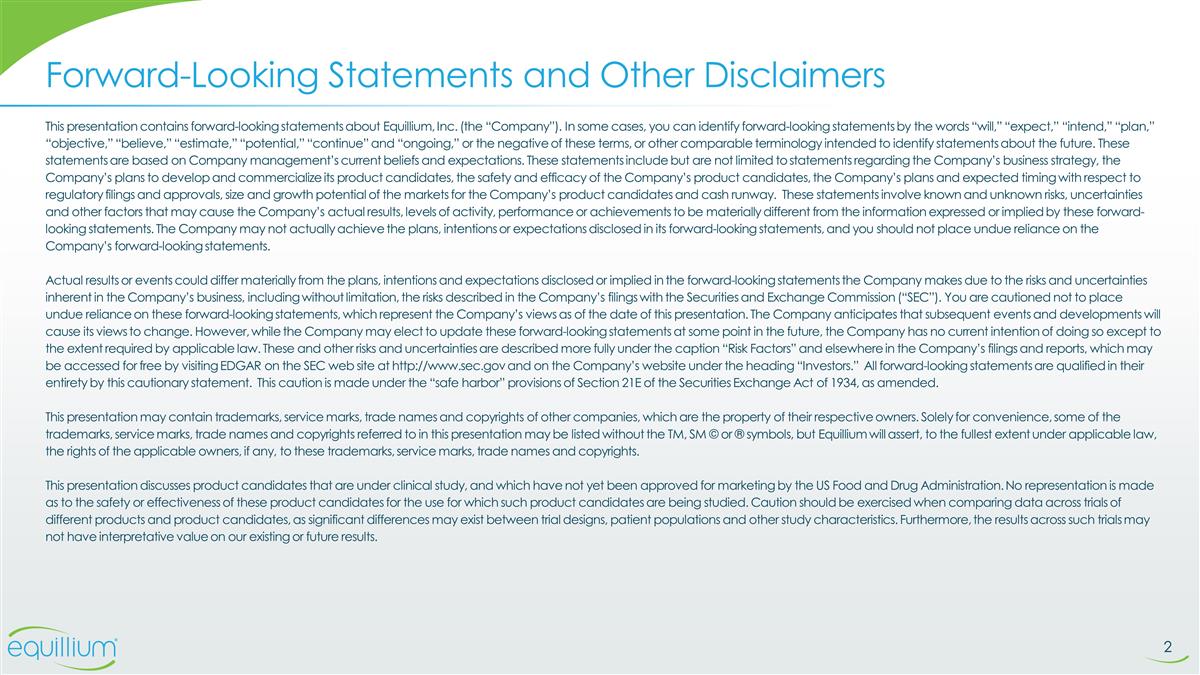
This presentation contains forward-looking statements about Equillium, Inc. (the “Company”). In some cases, you can identify forward-looking statements by the words “will,” “expect,” “intend,” “plan,” “objective,” “believe,” “estimate,” “potential,” “continue” and “ongoing,” or the negative of these terms, or other comparable terminology intended to identify statements about the future. These statements are based on Company management’s current beliefs and expectations. These statements include but are not limited to statements regarding the Company’s business strategy, the Company’s plans to develop and commercialize its product candidates, the safety and efficacy of the Company’s product candidates, the Company’s plans and expected timing with respect to regulatory filings and approvals, size and growth potential of the markets for the Company’s product candidates and cash runway. These statements involve known and unknown risks, uncertainties and other factors that may cause the Company’s actual results, levels of activity, performance or achievements to be materially different from the information expressed or implied by these forward-looking statements. The Company may not actually achieve the plans, intentions or expectations disclosed in its forward-looking statements, and you should not place undue reliance on the Company’s forward-looking statements. Actual results or events could differ materially from the plans, intentions and expectations disclosed or implied in the forward-looking statements the Company makes due to the risks and uncertainties inherent in the Company’s business, including without limitation, the risks described in the Company’s filings with the Securities and Exchange Commission (“SEC”). You are cautioned not to place undue reliance on these forward-looking statements, which represent the Company’s views as of the date of this presentation. The Company anticipates that subsequent events and developments will cause its views to change. However, while the Company may elect to update these forward-looking statements at some point in the future, the Company has no current intention of doing so except to the extent required by applicable law. These and other risks and uncertainties are described more fully under the caption “Risk Factors” and elsewhere in the Company’s filings and reports, which may be accessed for free by visiting EDGAR on the SEC web site at http://www.sec.gov and on the Company’s website under the heading “Investors.” All forward-looking statements are qualified in their entirety by this cautionary statement. This caution is made under the “safe harbor” provisions of Section 21E of the Securities Exchange Act of 1934, as amended. This presentation may contain trademarks, service marks, trade names and copyrights of other companies, which are the property of their respective owners. Solely for convenience, some of the trademarks, service marks, trade names and copyrights referred to in this presentation may be listed without the TM, SM © or ® symbols, but Equillium will assert, to the fullest extent under applicable law, the rights of the applicable owners, if any, to these trademarks, service marks, trade names and copyrights. This presentation discusses product candidates that are under clinical study, and which have not yet been approved for marketing by the US Food and Drug Administration. No representation is made as to the safety or effectiveness of these product candidates for the use for which such product candidates are being studied. Caution should be exercised when comparing data across trials of different products and product candidates, as significant differences may exist between trial designs, patient populations and other study characteristics. Furthermore, the results across such trials may not have interpretative value on our existing or future results. Forward-Looking Statements and Other Disclaimers
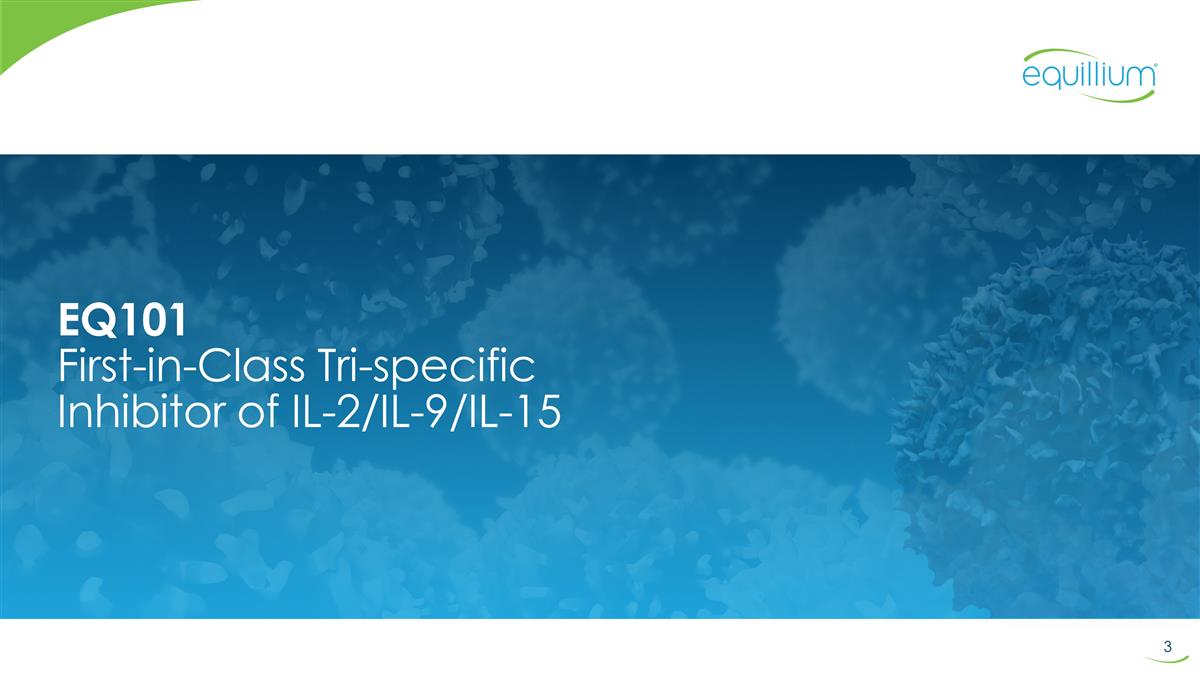
EQ101 First-in-Class Tri-specific Inhibitor of IL-2/IL-9/IL-15
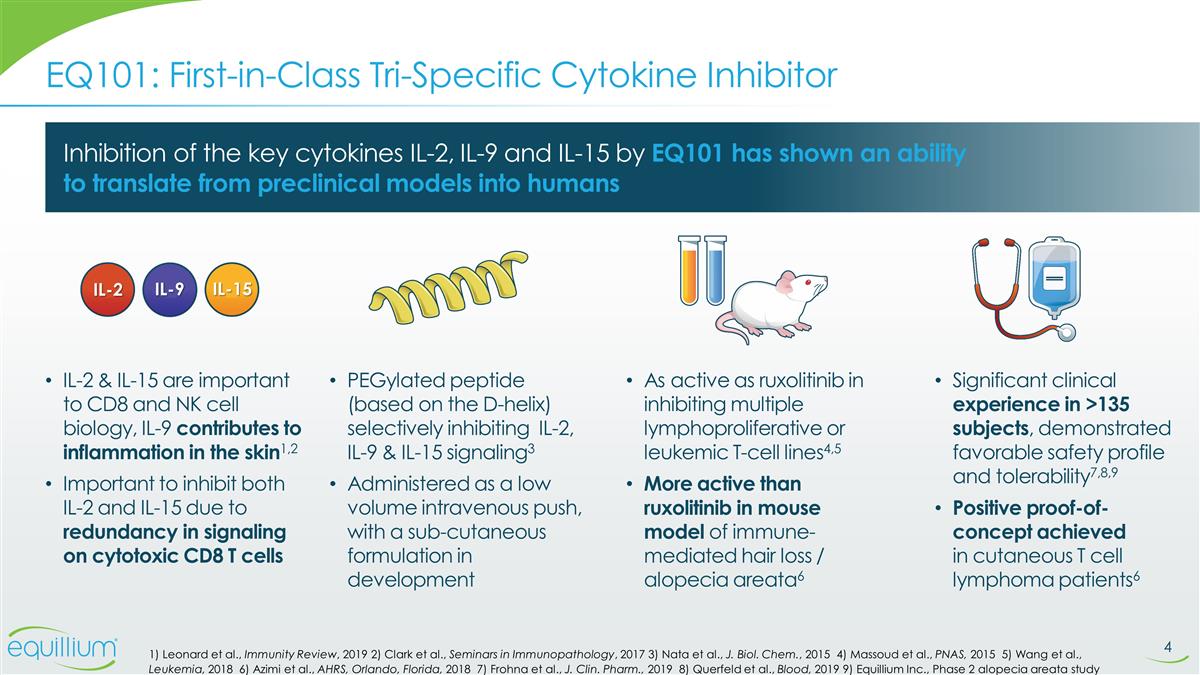
EQ101: First-in-Class Tri-Specific Cytokine Inhibitor Inhibition of the key cytokines IL-2, IL-9 and IL-15 by EQ101 has shown an ability to translate from preclinical models into humans IL-2 IL-9 IL-15 Significant clinical experience in >135 subjects, demonstrated favorable safety profile and tolerability7,8,9 Positive proof-of-concept achieved in cutaneous T cell lymphoma patients6 As active as ruxolitinib in inhibiting multiple lymphoproliferative or leukemic T-cell lines4,5 More active than ruxolitinib in mouse model of immune-mediated hair loss / alopecia areata6 IL-2 & IL-15 are important to CD8 and NK cell biology, IL-9 contributes to inflammation in the skin1,2 Important to inhibit both IL-2 and IL-15 due to redundancy in signaling on cytotoxic CD8 T cells PEGylated peptide (based on the D-helix) selectively inhibiting IL-2, IL-9 & IL-15 signaling3 Administered as a low volume intravenous push, with a sub-cutaneous formulation in development 1) Leonard et al., Immunity Review, 2019 2) Clark et al., Seminars in Immunopathology, 2017 3) Nata et al., J. Biol. Chem., 2015 4) Massoud et al., PNAS, 2015 5) Wang et al., Leukemia, 2018 6) Azimi et al., AHRS, Orlando, Florida, 2018 7) Frohna et al., J. Clin. Pharm., 2019 8) Querfeld et al., Blood, 2019 9) Equillium Inc., Phase 2 alopecia areata study
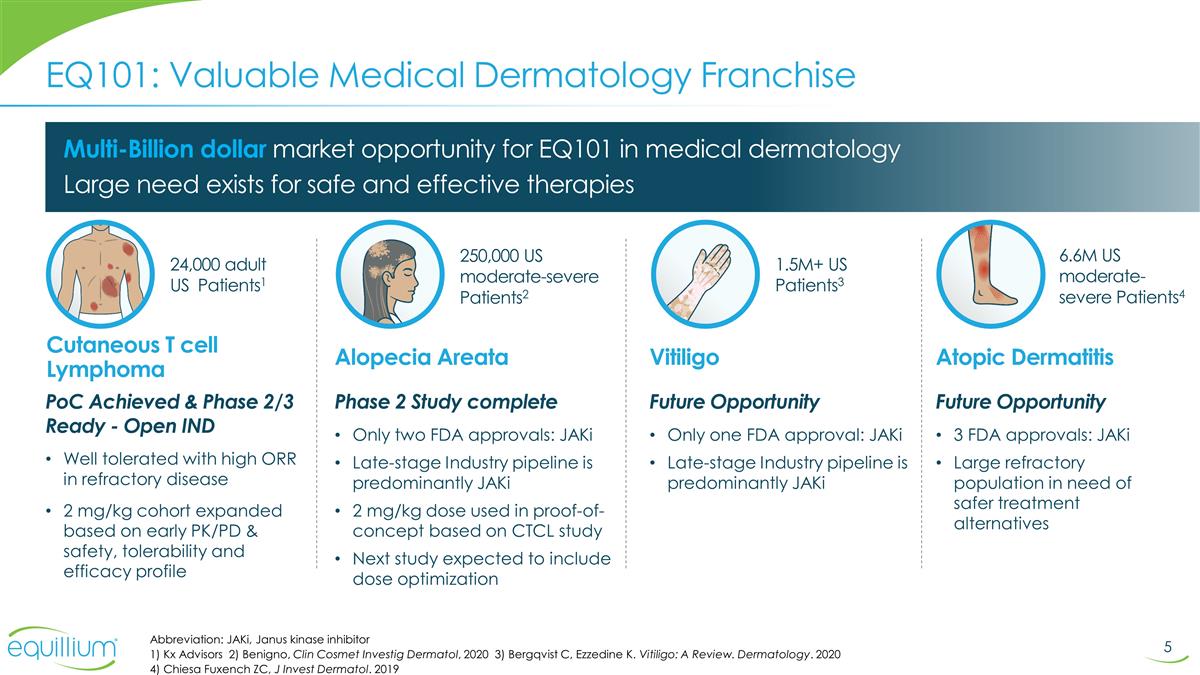
Multi-Billion dollar market opportunity for EQ101 in medical dermatology Large need exists for safe and effective therapies Abbreviation: JAKi, Janus kinase inhibitor 1) Kx Advisors 2) Benigno, Clin Cosmet Investig Dermatol, 2020 3) Bergqvist C, Ezzedine K. Vitiligo: A Review. Dermatology. 2020 4) Chiesa Fuxench ZC, J Invest Dermatol. 2019 EQ101: Valuable Medical Dermatology Franchise Future Opportunity 3 FDA approvals: JAKi Large refractory population in need of safer treatment alternatives Atopic Dermatitis 6.6M US moderate-severe Patients4 Cutaneous T cell Lymphoma PoC Achieved & Phase 2/3 Ready - Open IND Well tolerated with high ORR in refractory disease 2 mg/kg cohort expanded based on early PK/PD & safety, tolerability and efficacy profile 24,000 adult US Patients1 Vitiligo Future Opportunity Only one FDA approval: JAKi Late-stage Industry pipeline is predominantly JAKi 1.5M+ US Patients3 Alopecia Areata Phase 2 Study complete Only two FDA approvals: JAKi Late-stage Industry pipeline is predominantly JAKi 2 mg/kg dose used in proof-of-concept based on CTCL study Next study expected to include dose optimization 250,000 US moderate-severe Patients2
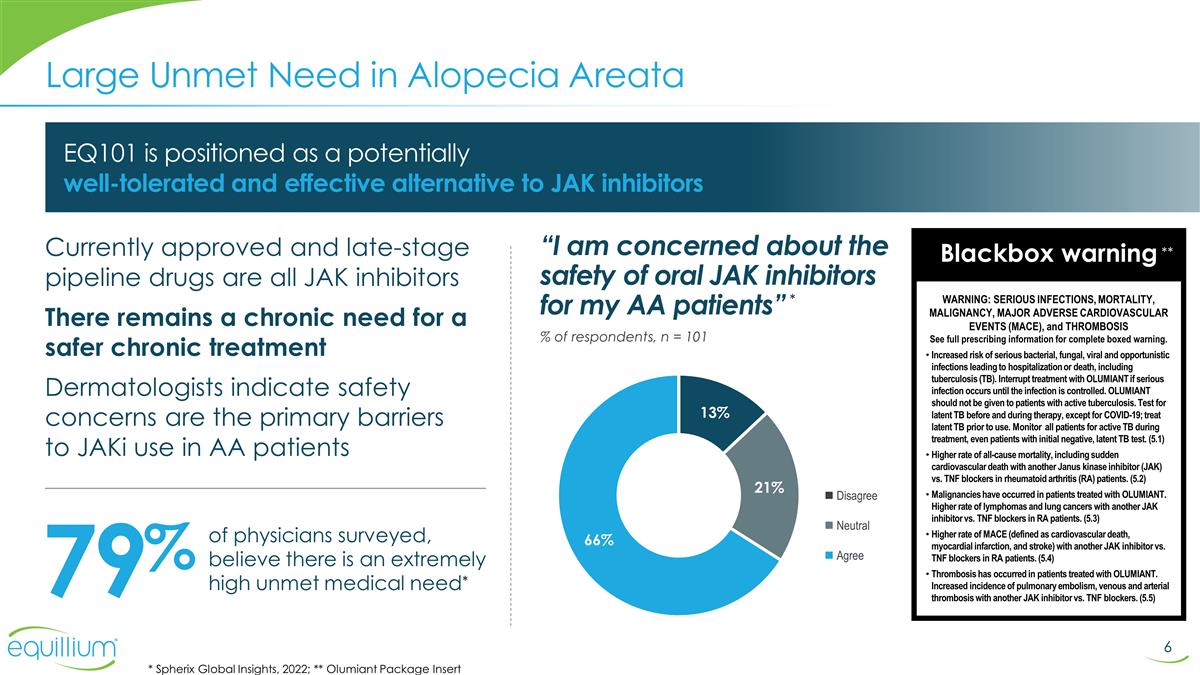
Large Unmet Need in Alopecia Areata “I am concerned about the safety of oral JAK inhibitors for my AA patients” % of respondents, n = 101 Currently approved and late-stage pipeline drugs are all JAK inhibitors There remains a chronic need for a safer chronic treatment Dermatologists indicate safety concerns are the primary barriers to JAKi use in AA patients * Spherix Global Insights, 2022; ** Olumiant Package Insert 79% of physicians surveyed, believe there is an extremely high unmet medical need EQ101 is positioned as a potentially well-tolerated and effective alternative to JAK inhibitors * Blackbox warning WARNING: SERIOUS INFECTIONS, MORTALITY, MALIGNANCY, MAJOR ADVERSE CARDIOVASCULAR EVENTS (MACE), and THROMBOSIS See full prescribing information for complete boxed warning. Increased risk of serious bacterial, fungal, viral and opportunistic infections leading to hospitalization or death, including tuberculosis (TB). Interrupt treatment with OLUMIANT if serious infection occurs until the infection is controlled. OLUMIANT should not be given to patients with active tuberculosis. Test for latent TB before and during therapy, except for COVID-19; treat latent TB prior to use. Monitor all patients for active TB during treatment, even patients with initial negative, latent TB test. (5.1) Higher rate of all-cause mortality, including sudden cardiovascular death with another Janus kinase inhibitor (JAK) vs. TNF blockers in rheumatoid arthritis (RA) patients. (5.2) Malignancies have occurred in patients treated with OLUMIANT. Higher rate of lymphomas and lung cancers with another JAK inhibitor vs. TNF blockers in RA patients. (5.3) Higher rate of MACE (defined as cardiovascular death, myocardial infarction, and stroke) with another JAK inhibitor vs. TNF blockers in RA patients. (5.4) Thrombosis has occurred in patients treated with OLUMIANT. Increased incidence of pulmonary embolism, venous and arterial thrombosis with another JAK inhibitor vs. TNF blockers. (5.5) ** * Disagree n Neutral n Agree
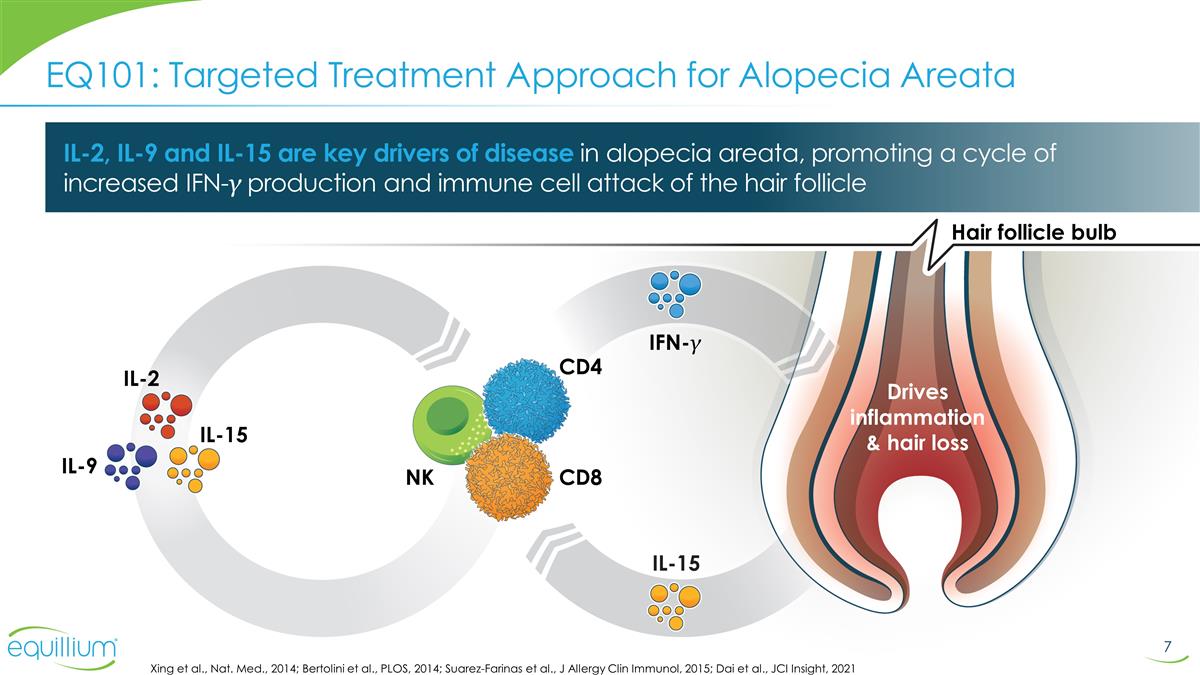
EQ101: Targeted Treatment Approach for Alopecia Areata IFN-γ Drives inflammation & hair loss IL-15 IL-2 IL-9 IL-15 NK CD4 IL-2, IL-9 and IL-15 are key drivers of disease in alopecia areata, promoting a cycle of increased IFN-γ production and immune cell attack of the hair follicle Hair follicle bulb Xing et al., Nat. Med., 2014; Bertolini et al., PLOS, 2014; Suarez-Farinas et al., J Allergy Clin Immunol, 2015; Dai et al., JCI Insight, 2021 CD8
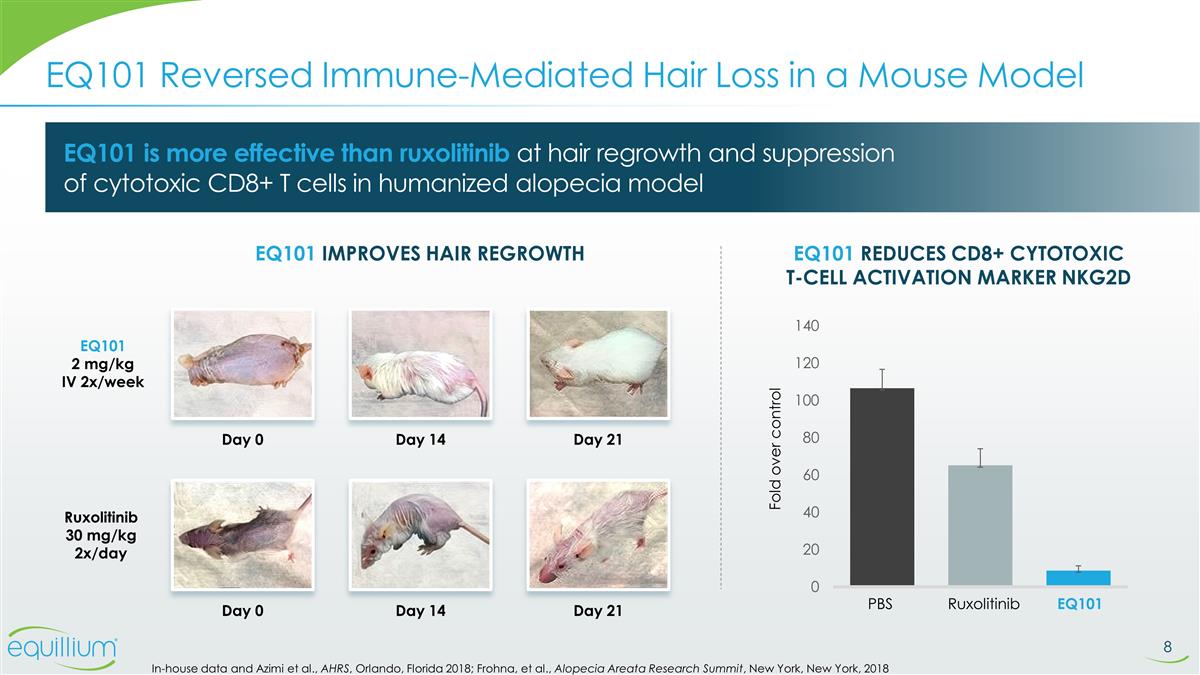
EQ101 2 mg/kg IV 2x/week Ruxolitinib 30 mg/kg 2x/day EQ101 Reversed Immune-Mediated Hair Loss in a Mouse Model EQ101 Reduces CD8+ Cytotoxic T-cell Activation Marker NKG2D Fold over control PBS Ruxolitinib EQ101 EQ101 is more effective than ruxolitinib at hair regrowth and suppression of cytotoxic CD8+ T cells in humanized alopecia model EQ101 Improves Hair Regrowth In-house data and Azimi et al., AHRS, Orlando, Florida 2018; Frohna, et al., Alopecia Areata Research Summit, New York, New York, 2018 Day 0 Day 14 Day 21 Day 0 Day 14 Day 21
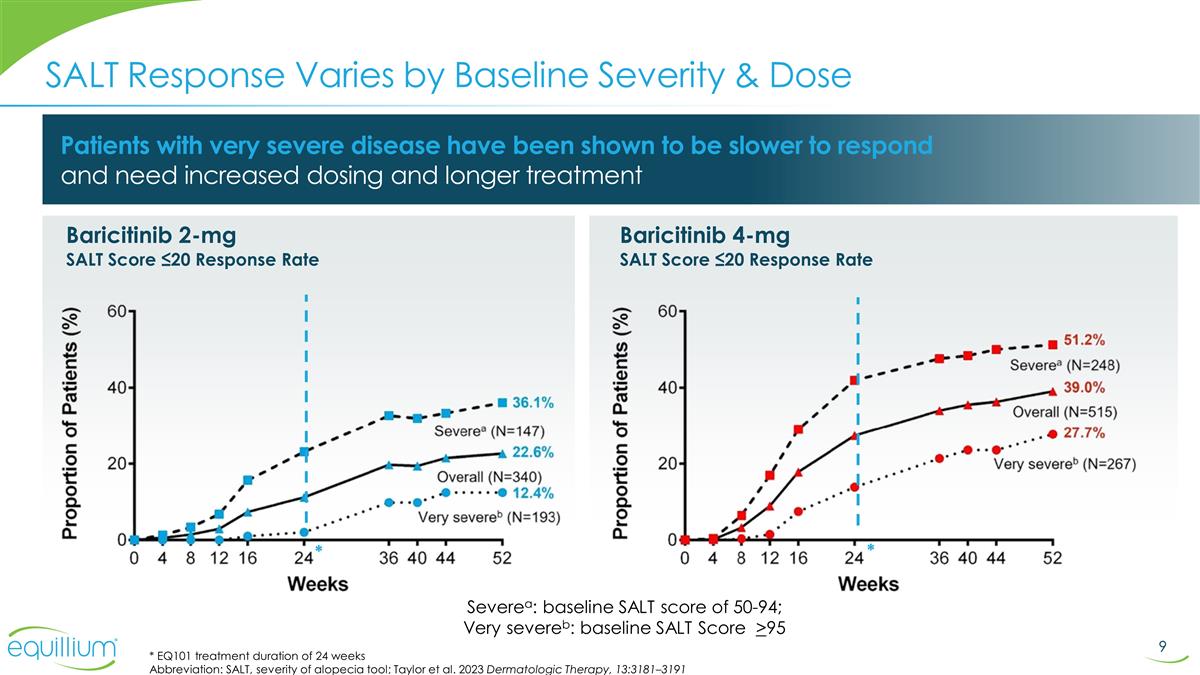
SALT Response Varies by Baseline Severity & Dose Severea: baseline SALT score of 50-94; Very severeb: baseline SALT Score >95 * SALT Score ≤20 Response Rate Baricitinib 2-mg SALT Score ≤20 Response Rate Baricitinib 4-mg * EQ101 treatment duration of 24 weeks Abbreviation: SALT, severity of alopecia tool; Taylor et al. 2023 Dermatologic Therapy, 13:3181–3191 Patients with very severe disease have been shown to be slower to respond and need increased dosing and longer treatment *
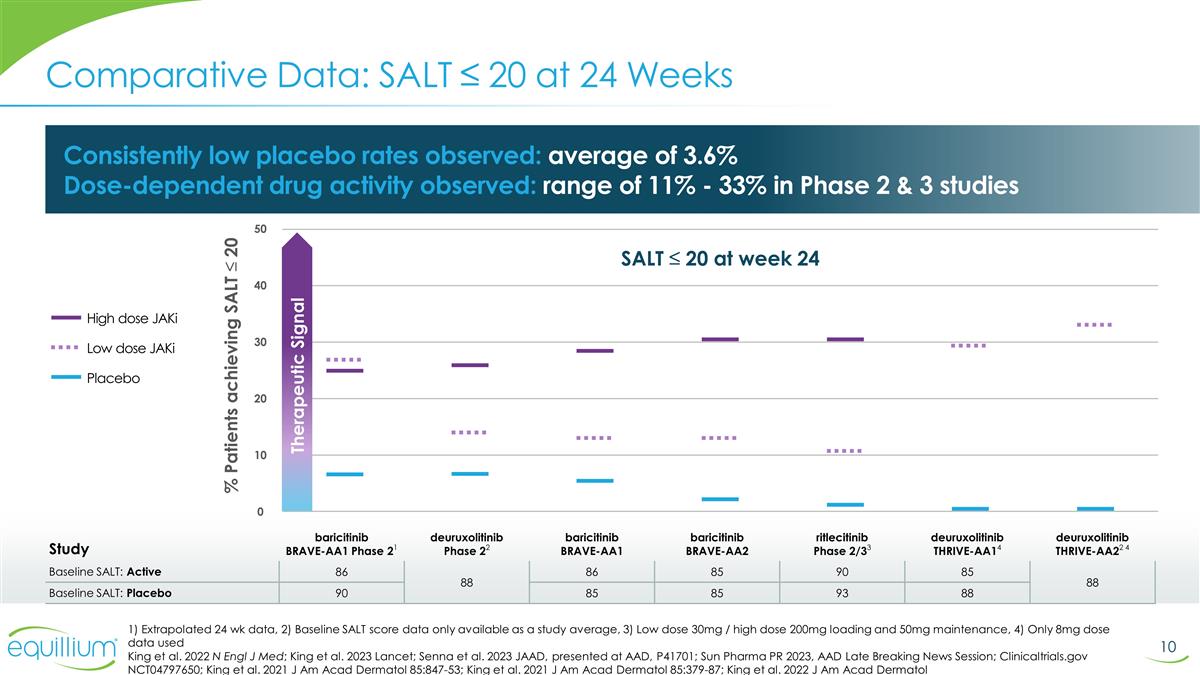
Comparative Data: SALT ≤ 20 at 24 Weeks SALT ≤ 20 at week 24 Study baricitinib BRAVE-AA1 Phase 21 deuruxolitinib Phase 22 baricitinib BRAVE-AA1 baricitinib BRAVE-AA2 ritlecitinib Phase 2/33 deuruxolitinib THRIVE-AA14 deuruxolitinib THRIVE-AA22 4 Baseline SALT: Active 86 88 86 85 90 85 88 Baseline SALT: Placebo 90 85 85 93 88 1) Extrapolated 24 wk data, 2) Baseline SALT score data only available as a study average, 3) Low dose 30mg / high dose 200mg loading and 50mg maintenance, 4) Only 8mg dose data used King et al. 2022 N Engl J Med; King et al. 2023 Lancet; Senna et al. 2023 JAAD, presented at AAD, P41701; Sun Pharma PR 2023, AAD Late Breaking News Session; Clinicaltrials.gov NCT04797650; King et al. 2021 J Am Acad Dermatol 85:847-53; King et al. 2021 J Am Acad Dermatol 85:379-87; King et al. 2022 J Am Acad Dermatol 50 % Patients achieving SALT ≤ 20 40 30 20 10 0 Therapeutic Signal High dose JAKi Low dose JAKi Placebo Consistently low placebo rates observed: average of 3.6% Dose-dependent drug activity observed: range of 11% - 33% in Phase 2 & 3 studies
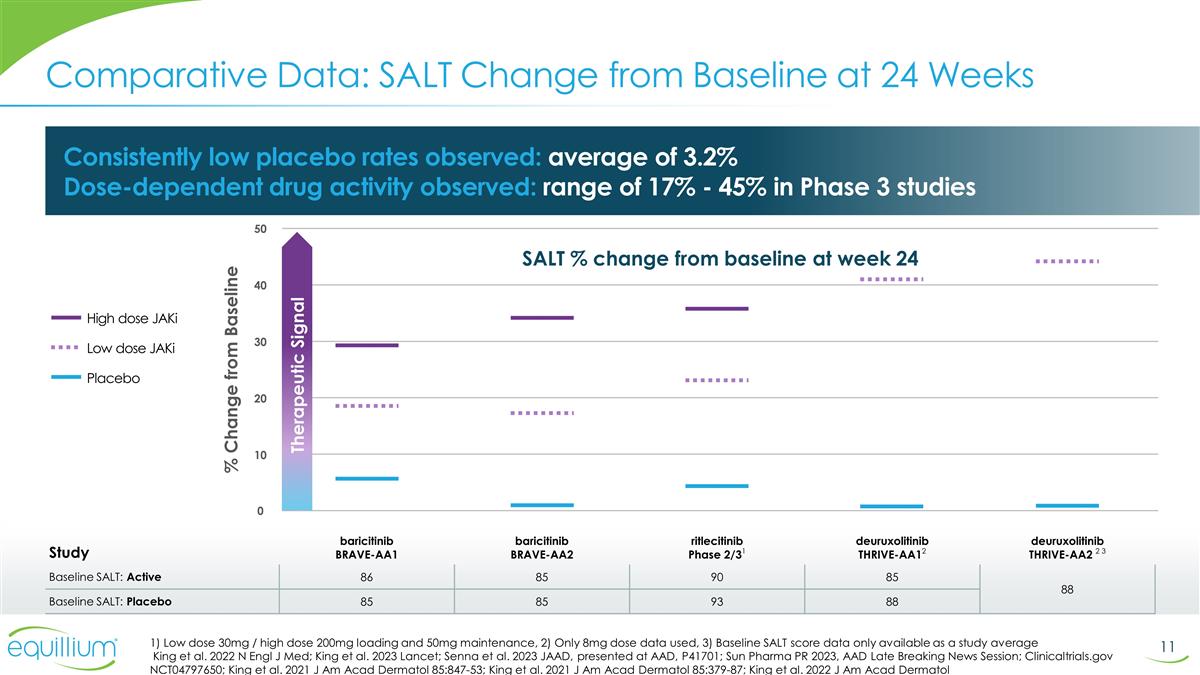
Comparative Data: SALT Change from Baseline at 24 Weeks 50 % Change from Baseline 40 30 20 10 0 Study baricitinib BRAVE-AA1 baricitinib BRAVE-AA2 ritlecitinib Phase 2/31 deuruxolitinib THRIVE-AA12 deuruxolitinib THRIVE-AA2 2 3 Baseline SALT: Active 86 85 90 85 88 Baseline SALT: Placebo 85 85 93 88 SALT % change from baseline at week 24 High dose JAKi Low dose JAKi Placebo Therapeutic Signal Consistently low placebo rates observed: average of 3.2% Dose-dependent drug activity observed: range of 17% - 45% in Phase 3 studies 1) Low dose 30mg / high dose 200mg loading and 50mg maintenance, 2) Only 8mg dose data used, 3) Baseline SALT score data only available as a study average King et al. 2022 N Engl J Med; King et al. 2023 Lancet; Senna et al. 2023 JAAD, presented at AAD, P41701; Sun Pharma PR 2023, AAD Late Breaking News Session; Clinicaltrials.gov NCT04797650; King et al. 2021 J Am Acad Dermatol 85:847-53; King et al. 2021 J Am Acad Dermatol 85:379-87; King et al. 2022 J Am Acad Dermatol
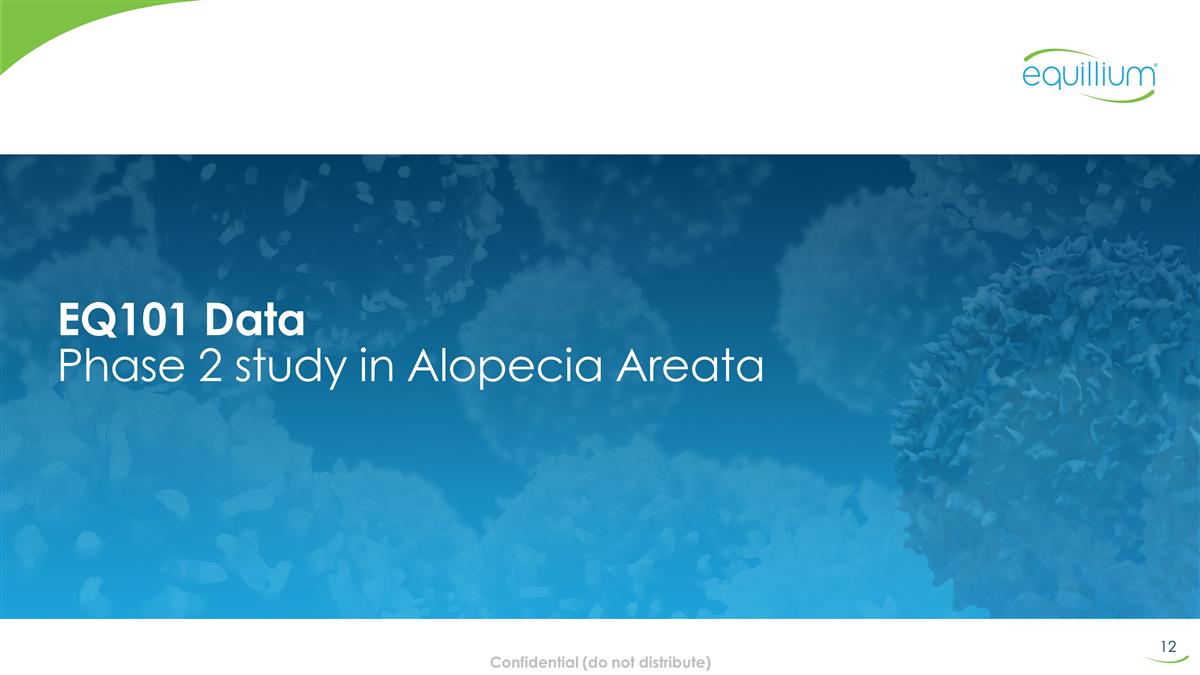
EQ101 Data Phase 2 study in Alopecia Areata Confidential (do not distribute)
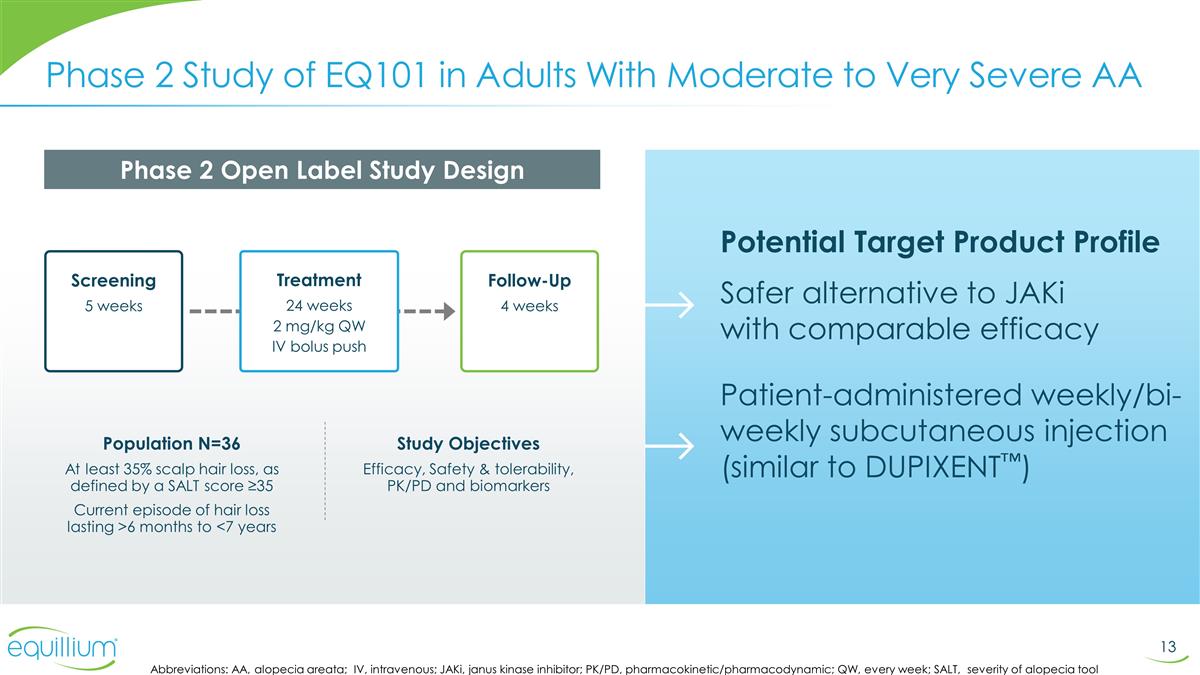
Phase 2 Study of EQ101 in Adults With Moderate to Very Severe AA Abbreviations: AA, alopecia areata; IV, intravenous; JAKi, janus kinase inhibitor; PK/PD, pharmacokinetic/pharmacodynamic; QW, every week; SALT, severity of alopecia tool Phase 2 Open Label Study Design Potential Target Product Profile Safer alternative to JAKi with comparable efficacy Patient-administered weekly/bi-weekly subcutaneous injection (similar to DUPIXENT™) Screening 5 weeks Follow-Up 4 weeks Treatment 24 weeks 2 mg/kg QW IV bolus push Study Objectives Efficacy, Safety & tolerability, PK/PD and biomarkers Population N=36 At least 35% scalp hair loss, as defined by a SALT score ≥35 Current episode of hair loss lasting >6 months to <7 years
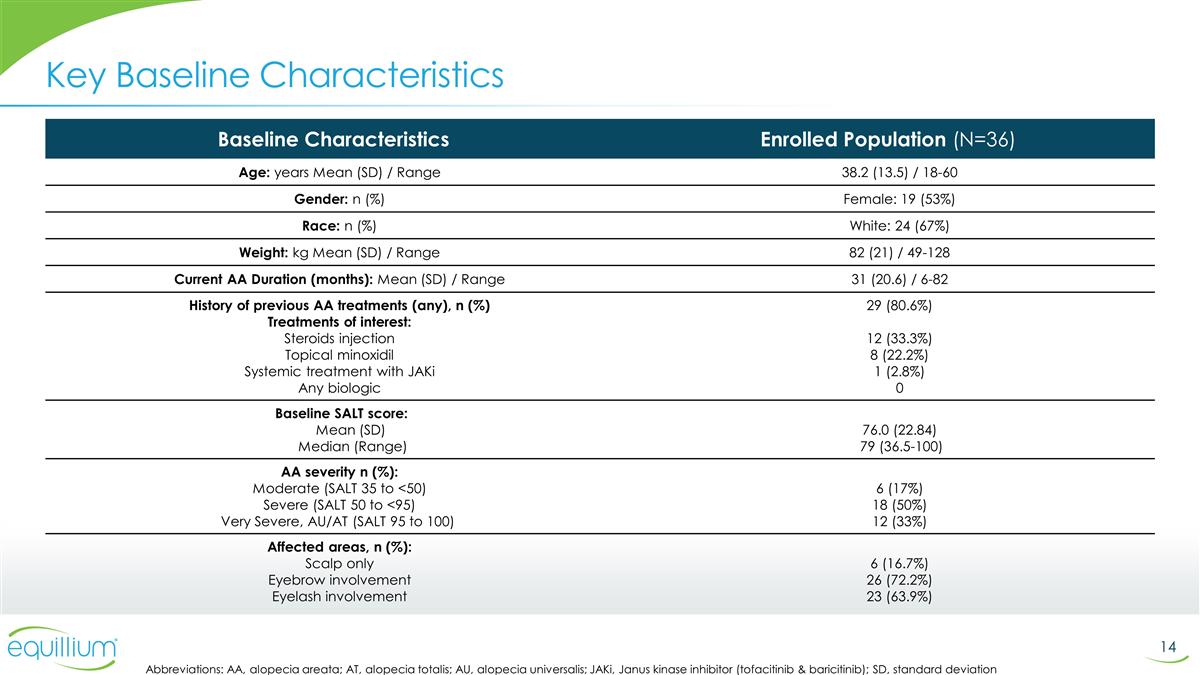
Key Baseline Characteristics Baseline Characteristics Enrolled Population (N=36) Age: years Mean (SD) / Range 38.2 (13.5) / 18-60 Gender: n (%) Female: 19 (53%) Race: n (%) White: 24 (67%) Weight: kg Mean (SD) / Range 82 (21) / 49-128 Current AA Duration (months): Mean (SD) / Range 31 (20.6) / 6-82 History of previous AA treatments (any), n (%) Treatments of interest: Steroids injection Topical minoxidil Systemic treatment with JAKi Any biologic 29 (80.6%) 12 (33.3%) 8 (22.2%) 1 (2.8%) 0 Baseline SALT score: Mean (SD) Median (Range) 76.0 (22.84) 79 (36.5-100) AA severity n (%): Moderate (SALT 35 to <50) Severe (SALT 50 to <95) Very Severe, AU/AT (SALT 95 to 100) 6 (17%) 18 (50%) 12 (33%) Affected areas, n (%): Scalp only Eyebrow involvement Eyelash involvement 6 (16.7%) 26 (72.2%) 23 (63.9%) Abbreviations: AA, alopecia areata; AT, alopecia totalis; AU, alopecia universalis; JAKi, Janus kinase inhibitor (tofacitinib & baricitinib); SD, standard deviation
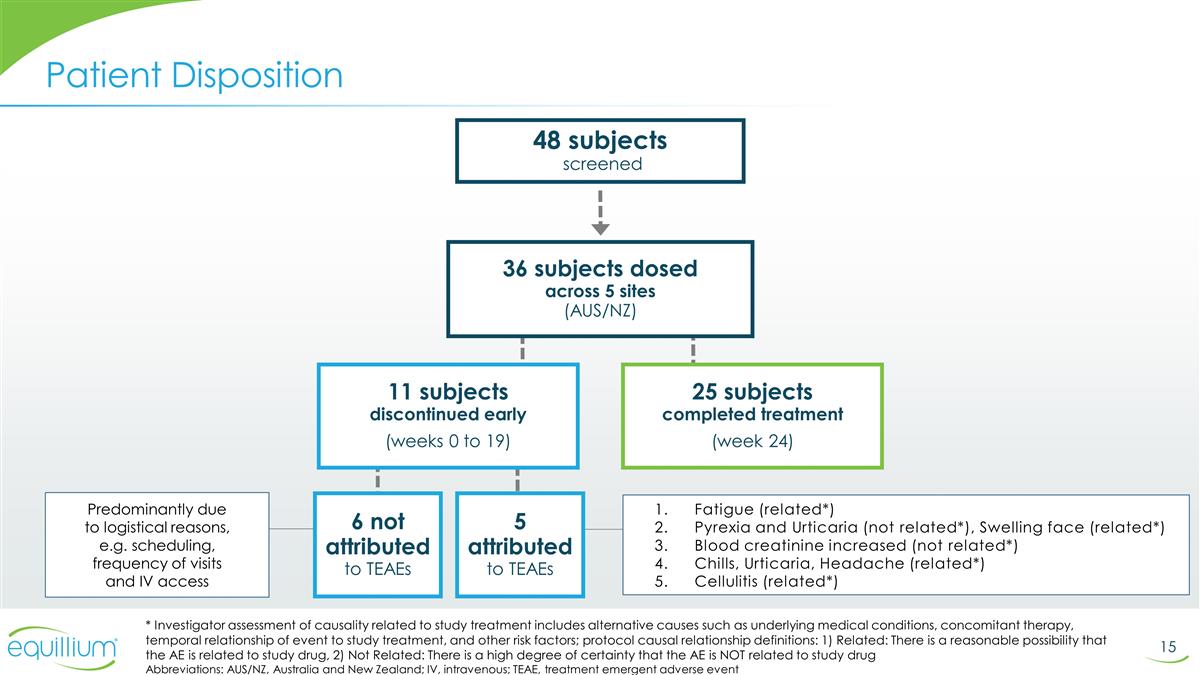
Patient Disposition 36 subjects dosed across 5 sites (AUS/NZ) 11 subjects discontinued early (weeks 0 to 19) 25 subjects completed treatment (week 24) 48 subjects screened 6 not attributed to TEAEs 5 attributed to TEAEs Fatigue (related*) Pyrexia and Urticaria (not related*), Swelling face (related*) Blood creatinine increased (not related*) Chills, Urticaria, Headache (related*) Cellulitis (related*) Predominantly due to logistical reasons, e.g. scheduling, frequency of visits and IV access * Investigator assessment of causality related to study treatment includes alternative causes such as underlying medical conditions, concomitant therapy, temporal relationship of event to study treatment, and other risk factors; protocol causal relationship definitions: 1) Related: There is a reasonable possibility that the AE is related to study drug, 2) Not Related: There is a high degree of certainty that the AE is NOT related to study drug Abbreviations: AUS/NZ, Australia and New Zealand; IV, intravenous; TEAE, treatment emergent adverse event
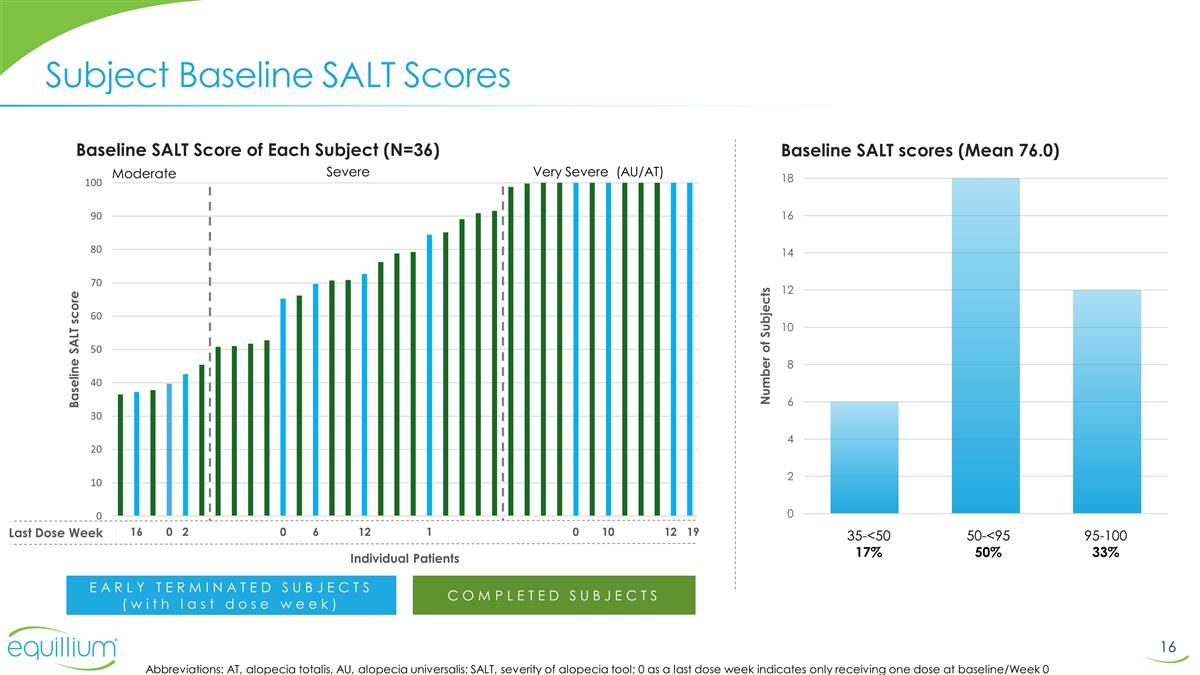
Subject Baseline SALT Scores Abbreviations: AT, alopecia totalis, AU, alopecia universalis; SALT, severity of alopecia tool; 0 as a last dose week indicates only receiving one dose at baseline/Week 0 EARLY TERMINATED SUBJECTS (with last dose week) COMPLETED SUBJECTS Last Dose Week Individual Patients 16 12 10 0 2 0 1 6 0 12 19
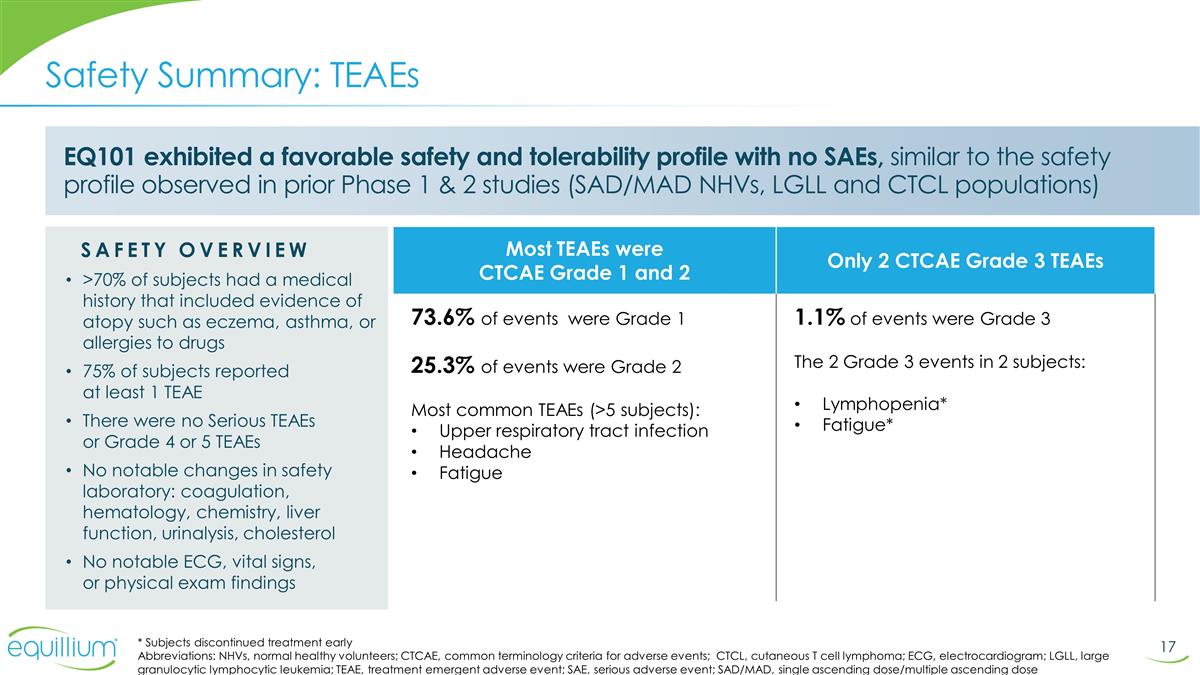
Safety Summary: TEAEs EQ101 exhibited a favorable safety and tolerability profile with no SAEs, similar to the safety profile observed in prior Phase 1 & 2 studies (SAD/MAD NHVs, LGLL and CTCL populations) SAFETY OVERVIEW >70% of subjects had a medical history that included evidence of atopy such as eczema, asthma, or allergies to drugs 75% of subjects reported at least 1 TEAE There were no Serious TEAEs or Grade 4 or 5 TEAEs No notable changes in safety laboratory: coagulation, hematology, chemistry, liver function, urinalysis, cholesterol No notable ECG, vital signs, or physical exam findings Most TEAEs were CTCAE Grade 1 and 2 Only 2 CTCAE Grade 3 TEAEs 73.6% of events were Grade 1 25.3% of events were Grade 2 Most common TEAEs (>5 subjects): Upper respiratory tract infection Headache Fatigue 1.1% of events were Grade 3 The 2 Grade 3 events in 2 subjects: Lymphopenia* Fatigue* * Subjects discontinued treatment early Abbreviations: NHVs, normal healthy volunteers; CTCAE, common terminology criteria for adverse events; CTCL, cutaneous T cell lymphoma; ECG, electrocardiogram; LGLL, large granulocytic lymphocytic leukemia; TEAE, treatment emergent adverse event; SAE, serious adverse event; SAD/MAD, single ascending dose/multiple ascending dose
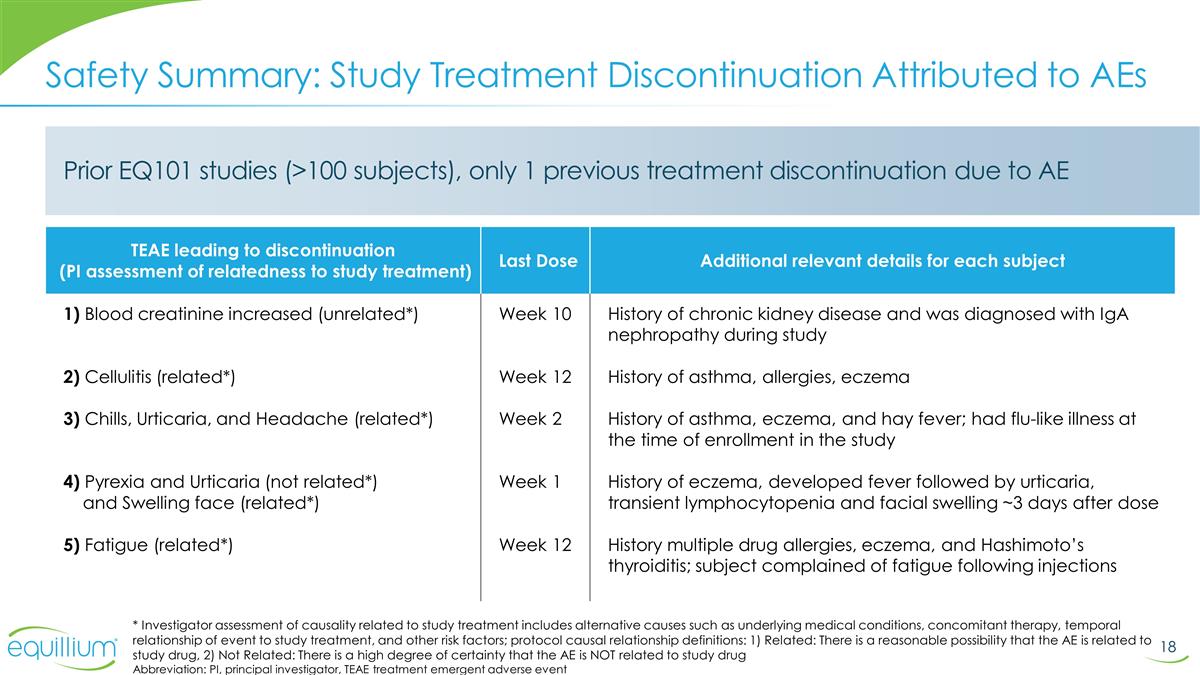
Safety Summary: Study Treatment Discontinuation Attributed to AEs * Investigator assessment of causality related to study treatment includes alternative causes such as underlying medical conditions, concomitant therapy, temporal relationship of event to study treatment, and other risk factors; protocol causal relationship definitions: 1) Related: There is a reasonable possibility that the AE is related to study drug, 2) Not Related: There is a high degree of certainty that the AE is NOT related to study drug Abbreviation: PI, principal investigator, TEAE treatment emergent adverse event Prior EQ101 studies (>100 subjects), only 1 previous treatment discontinuation due to AE TEAE leading to discontinuation (PI assessment of relatedness to study treatment) Last Dose Additional relevant details for each subject 1) Blood creatinine increased (unrelated*) 2) Cellulitis (related*) 3) Chills, Urticaria, and Headache (related*) 4) Pyrexia and Urticaria (not related*) and Swelling face (related*) 5) Fatigue (related*) Week 10 Week 12 Week 2 Week 1 Week 12 History of chronic kidney disease and was diagnosed with IgA nephropathy during study History of asthma, allergies, eczema History of asthma, eczema, and hay fever; had flu-like illness at the time of enrollment in the study History of eczema, developed fever followed by urticaria, transient lymphocytopenia and facial swelling ~3 days after dose History multiple drug allergies, eczema, and Hashimoto’s thyroiditis; subject complained of fatigue following injections
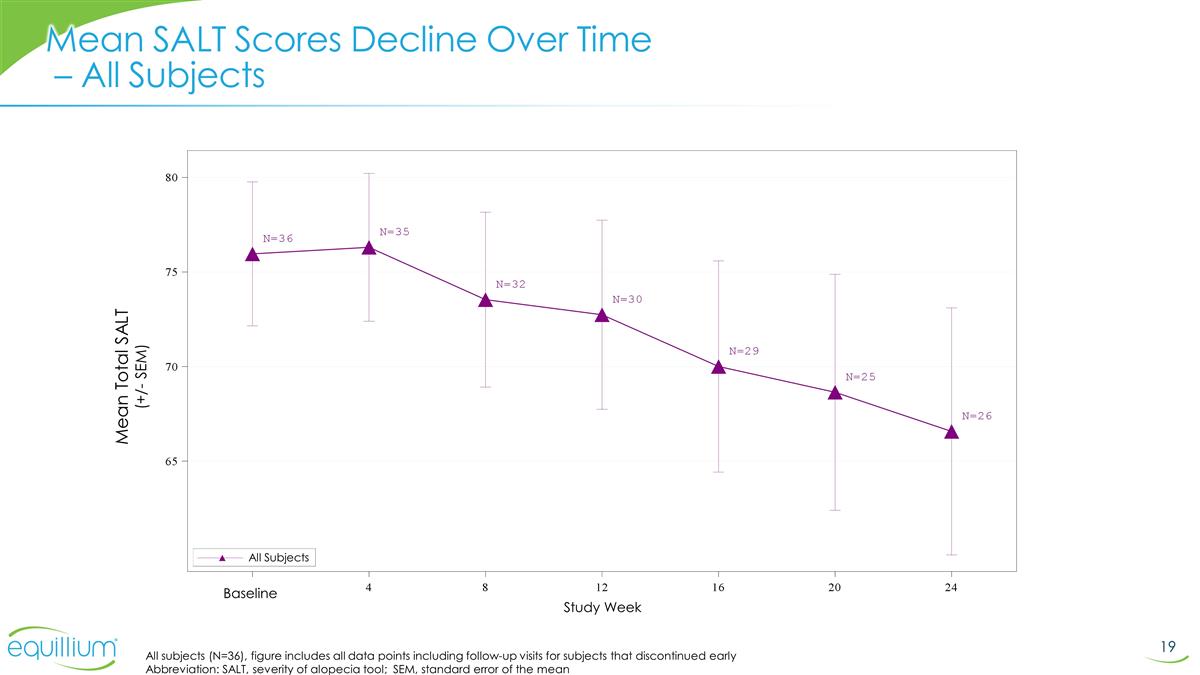
Mean SALT Scores Decline Over Time – All Subjects Mean Total SALT (+/- SEM) Baseline Study Week All Subjects All subjects (N=36), figure includes all data points including follow-up visits for subjects that discontinued early Abbreviation: SALT, severity of alopecia tool; SEM, standard error of the mean
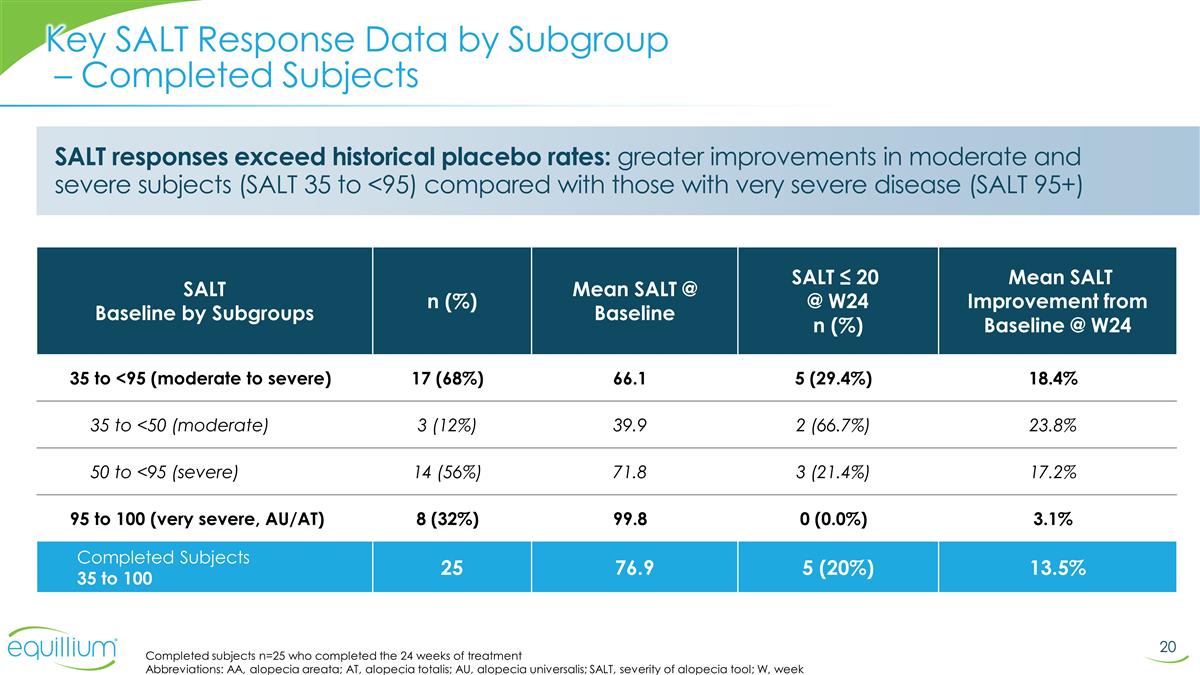
Key SALT Response Data by Subgroup – Completed Subjects SALT responses exceed historical placebo rates: greater improvements in moderate and severe subjects (SALT 35 to <95) compared with those with very severe disease (SALT 95+) SALT Baseline by Subgroups n (%) Mean SALT @ Baseline SALT ≤ 20 @ W24 n (%) Mean SALT Improvement from Baseline @ W24 35 to <95 (moderate to severe) 17 (68%) 66.1 5 (29.4%) 18.4% 35 to <50 (moderate) 3 (12%) 39.9 2 (66.7%) 23.8% 50 to <95 (severe) 14 (56%) 71.8 3 (21.4%) 17.2% 95 to 100 (very severe, AU/AT) 8 (32%) 99.8 0 (0.0%) 3.1% Completed Subjects 35 to 100 25 76.9 5 (20%) 13.5% Completed subjects n=25 who completed the 24 weeks of treatment Abbreviations: AA, alopecia areata; AT, alopecia totalis; AU, alopecia universalis; SALT, severity of alopecia tool; W, week
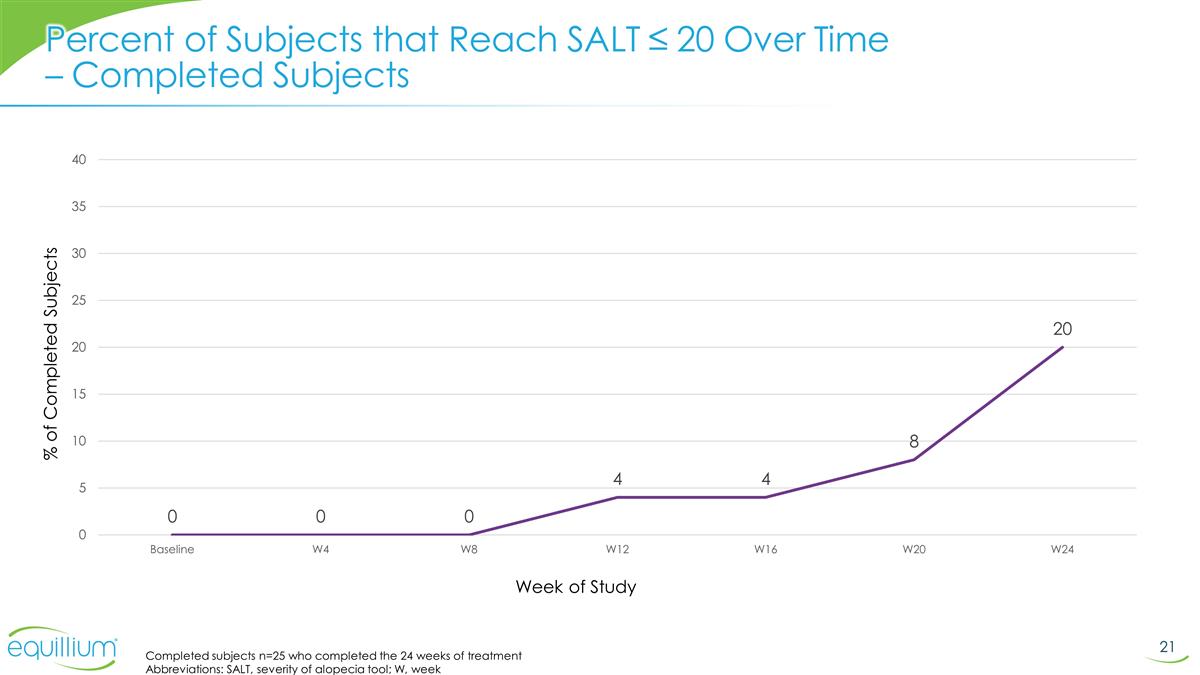
Percent of Subjects that Reach SALT ≤ 20 Over Time – Completed Subjects % of Completed Subjects Week of Study Completed subjects n=25 who completed the 24 weeks of treatment Abbreviations: SALT, severity of alopecia tool; W, week
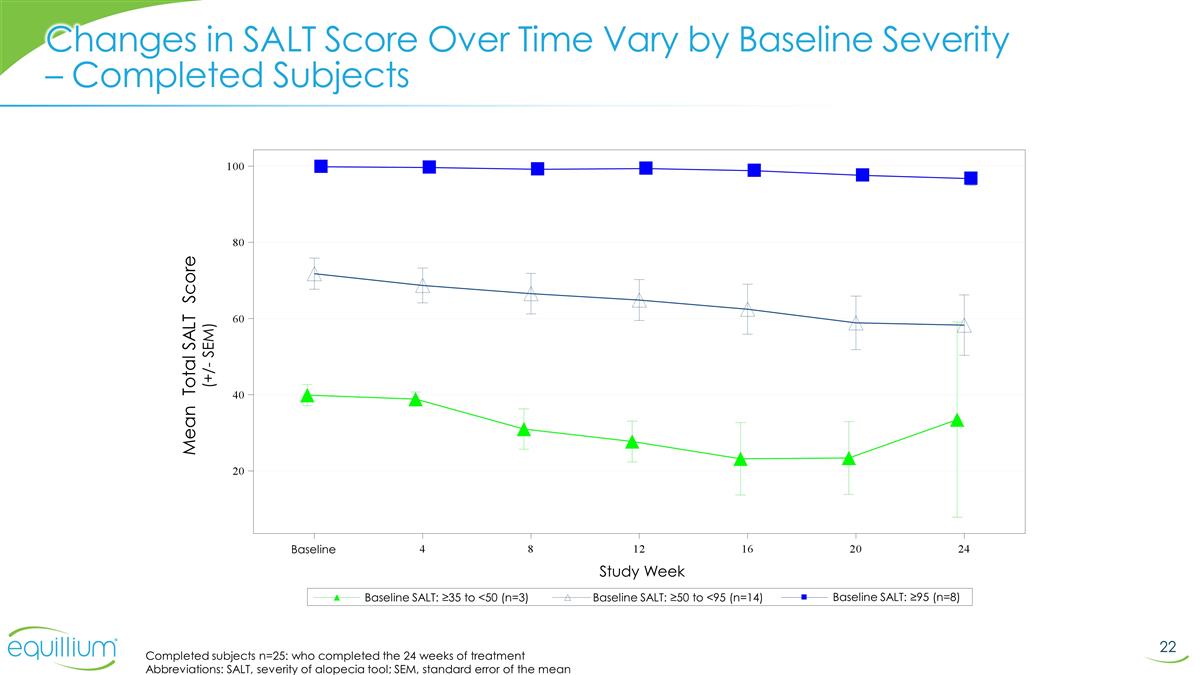
Changes in SALT Score Over Time Vary by Baseline Severity – Completed Subjects Mean Total SALT Score (+/- SEM) Baseline SALT: ≥35 to <50 (n=3) Study Week Baseline Baseline SALT: ≥50 to <95 (n=14) Baseline SALT: ≥95 (n=8) Completed subjects n=25: who completed the 24 weeks of treatment Abbreviations: SALT, severity of alopecia tool; SEM, standard error of the mean
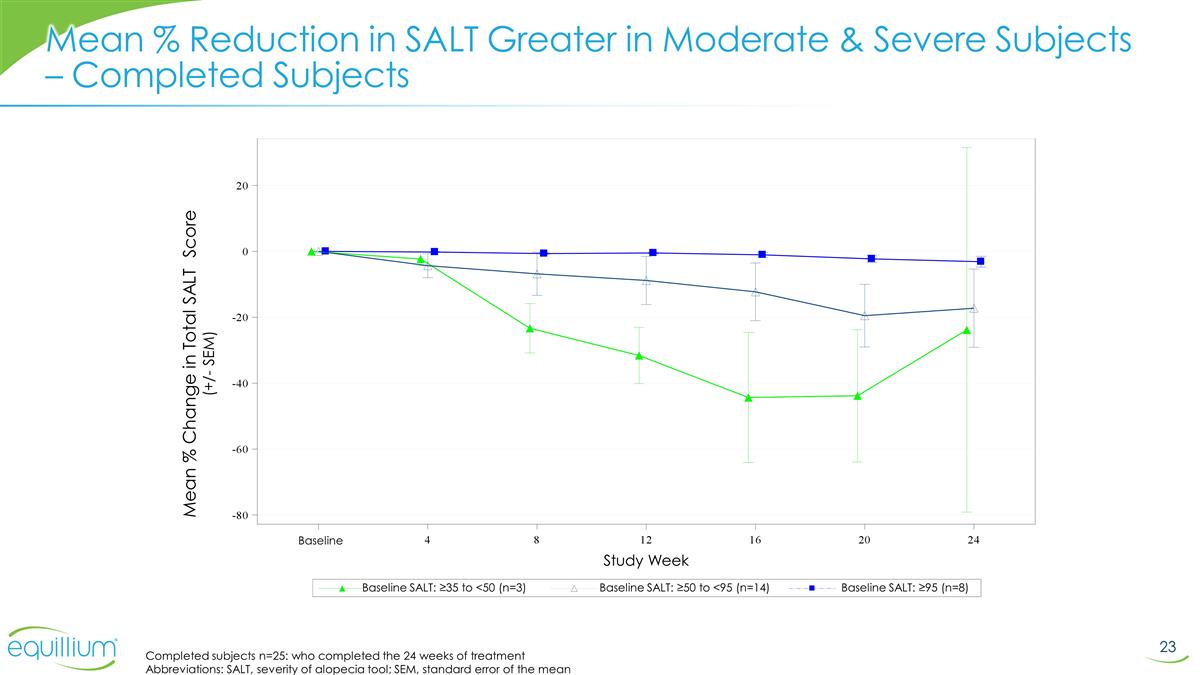
Mean % Reduction in SALT Greater in Moderate & Severe Subjects – Completed Subjects Mean % Change in Total SALT Score (+/- SEM) Baseline SALT: ≥35 to <50 (n=3) Study Week Baseline Baseline SALT: ≥50 to <95 (n=14) Baseline SALT: ≥95 (n=8) Completed subjects n=25: who completed the 24 weeks of treatment Abbreviations: SALT, severity of alopecia tool; SEM, standard error of the mean
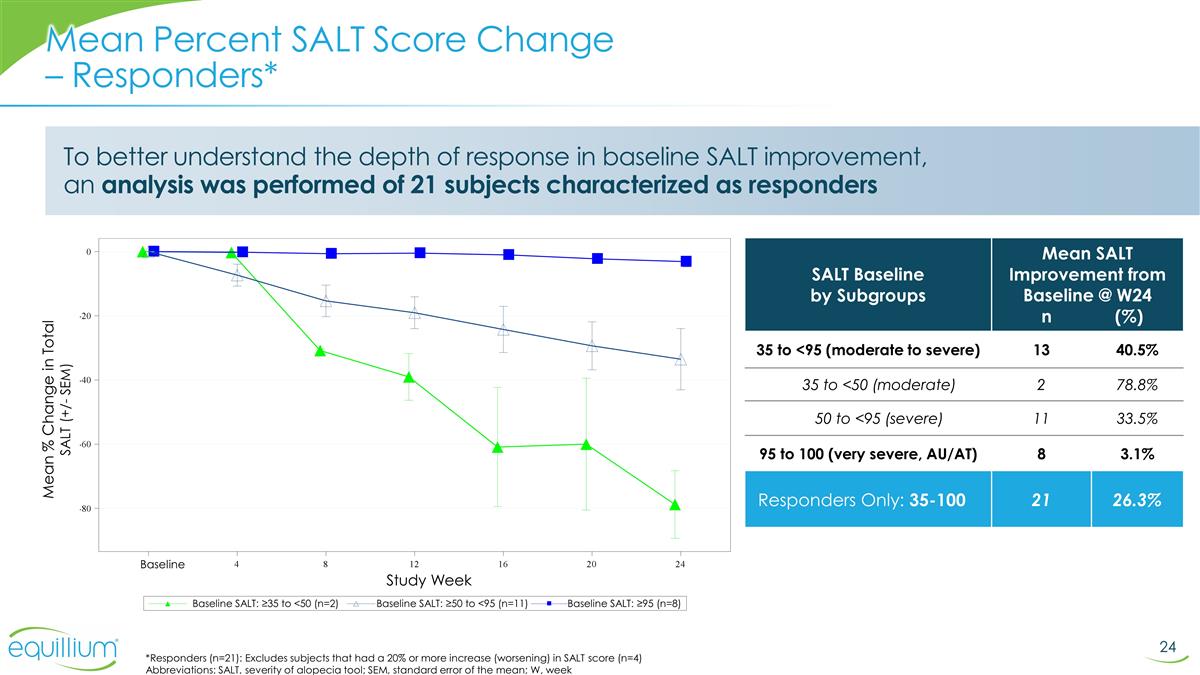
Mean Percent SALT Score Change – Responders* Mean % Change in Total SALT (+/- SEM) Baseline Study Week Baseline SALT: ≥35 to <50 (n=2) Baseline SALT: ≥50 to <95 (n=11) Baseline SALT: ≥95 (n=8) *Responders (n=21): Excludes subjects that had a 20% or more increase (worsening) in SALT score (n=4) Abbreviations: SALT, severity of alopecia tool; SEM, standard error of the mean; W, week SALT Baseline by Subgroups Mean SALT Improvement from Baseline @ W24 n (%) 35 to <95 (moderate to severe) 13 40.5% 35 to <50 (moderate) 2 78.8% 50 to <95 (severe) 11 33.5% 95 to 100 (very severe, AU/AT) 8 3.1% Responders Only: 35-100 21 26.3% To better understand the depth of response in baseline SALT improvement, an analysis was performed of 21 subjects characterized as responders
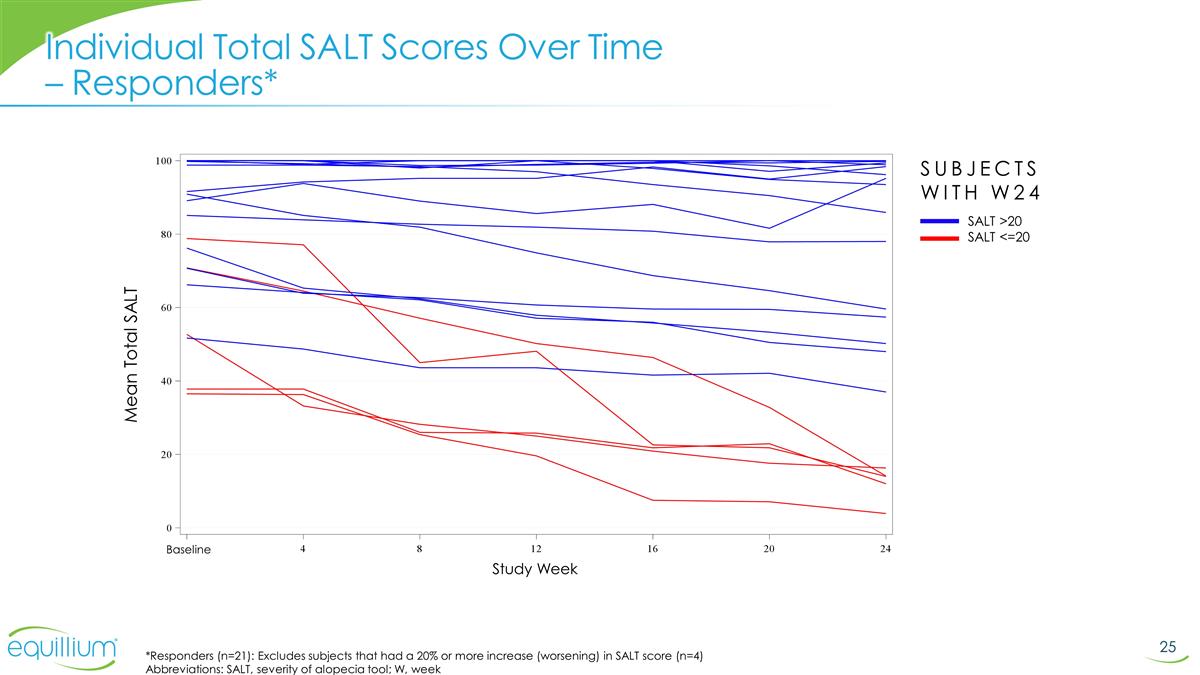
Individual Total SALT Scores Over Time – Responders* Baseline Study Week Mean Total SALT *Responders (n=21): Excludes subjects that had a 20% or more increase (worsening) in SALT score (n=4) Abbreviations: SALT, severity of alopecia tool; W, week SALT >20 SALT <=20 SUBJECTS WITH W24
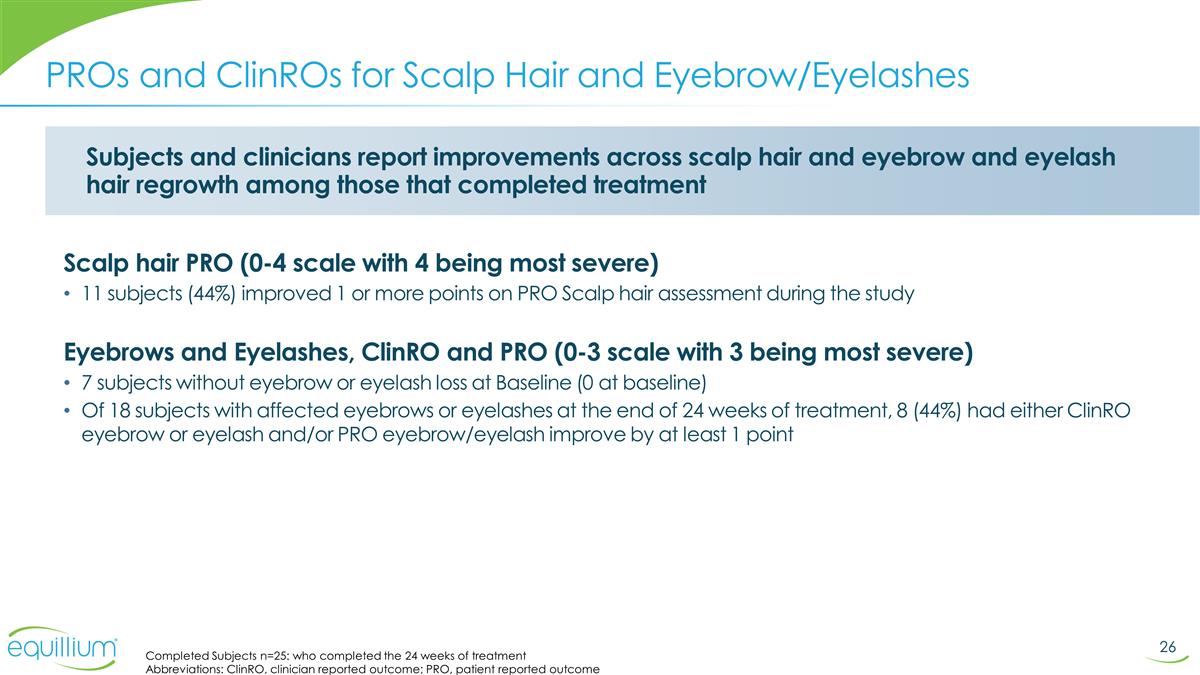
PROs and ClinROs for Scalp Hair and Eyebrow/Eyelashes Subjects and clinicians report improvements across scalp hair and eyebrow and eyelash hair regrowth among those that completed treatment Scalp hair PRO (0-4 scale with 4 being most severe) 11 subjects (44%) improved 1 or more points on PRO Scalp hair assessment during the study Eyebrows and Eyelashes, ClinRO and PRO (0-3 scale with 3 being most severe) 7 subjects without eyebrow or eyelash loss at Baseline (0 at baseline) Of 18 subjects with affected eyebrows or eyelashes at the end of 24 weeks of treatment, 8 (44%) had either ClinRO eyebrow or eyelash and/or PRO eyebrow/eyelash improve by at least 1 point Completed Subjects n=25: who completed the 24 weeks of treatment Abbreviations: ClinRO, clinician reported outcome; PRO, patient reported outcome
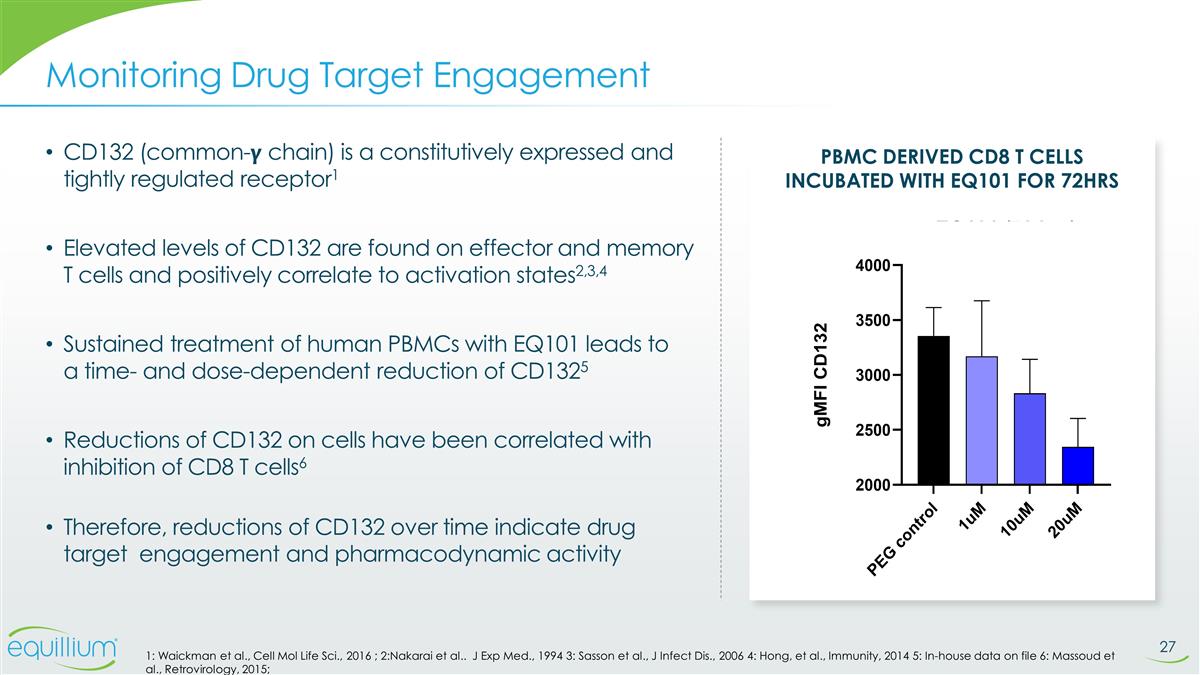
CD132 (common-�� chain) is a constitutively expressed and tightly regulated receptor1 Elevated levels of CD132 are found on effector and memory T cells and positively correlate to activation states2,3,4 Sustained treatment of human PBMCs with EQ101 leads to a time- and dose-dependent reduction of CD1325 Reductions of CD132 on cells have been correlated with inhibition of CD8 T cells6 Therefore, reductions of CD132 over time indicate drug target engagement and pharmacodynamic activity Monitoring Drug Target Engagement 1: Waickman et al., Cell Mol Life Sci., 2016 ; 2:Nakarai et al.. J Exp Med., 1994 3: Sasson et al., J Infect Dis., 2006 4: Hong, et al., Immunity, 2014 5: In-house data on file 6: Massoud et al., Retrovirology, 2015; PBMC derived CD8 T cells incubated with EQ101 for 72hrs
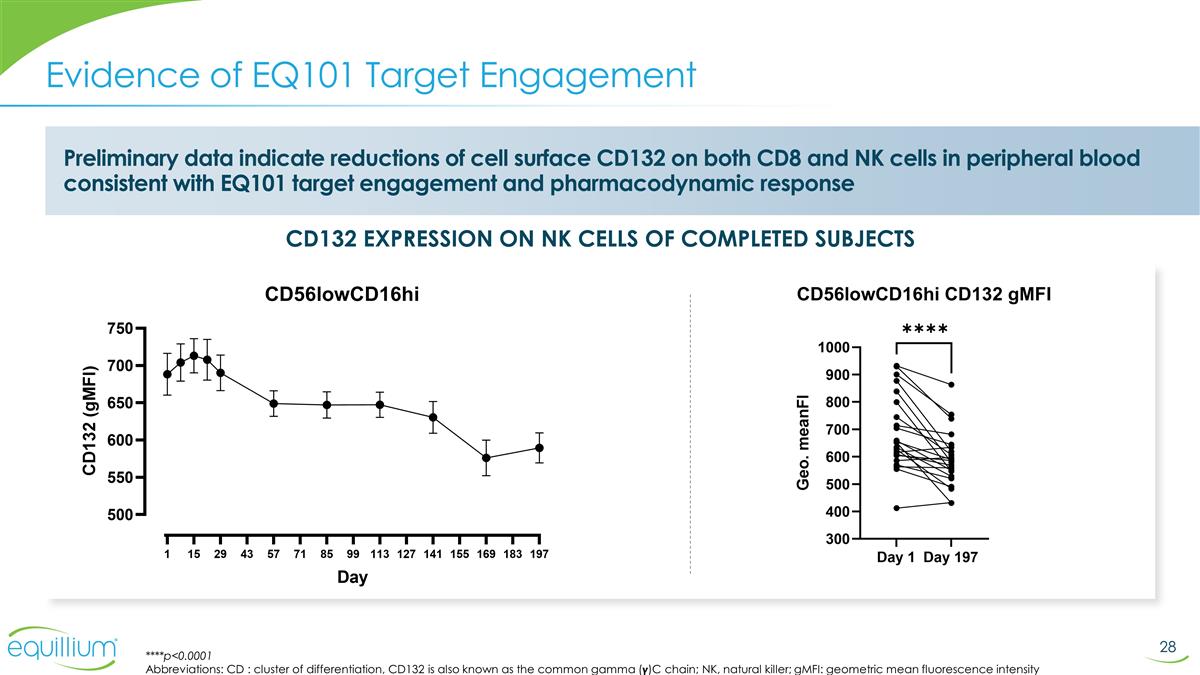
Evidence of EQ101 Target Engagement Preliminary data indicate reductions of cell surface CD132 on both CD8 and NK cells in peripheral blood consistent with EQ101 target engagement and pharmacodynamic response CD132 EXPRESSION ON NK CELLS OF COMPLETED SUBJECTS ****p<0.0001 Abbreviations: CD : cluster of differentiation, CD132 is also known as the common gamma (��)C chain; NK, natural killer; gMFI: geometric mean fluorescence intensity
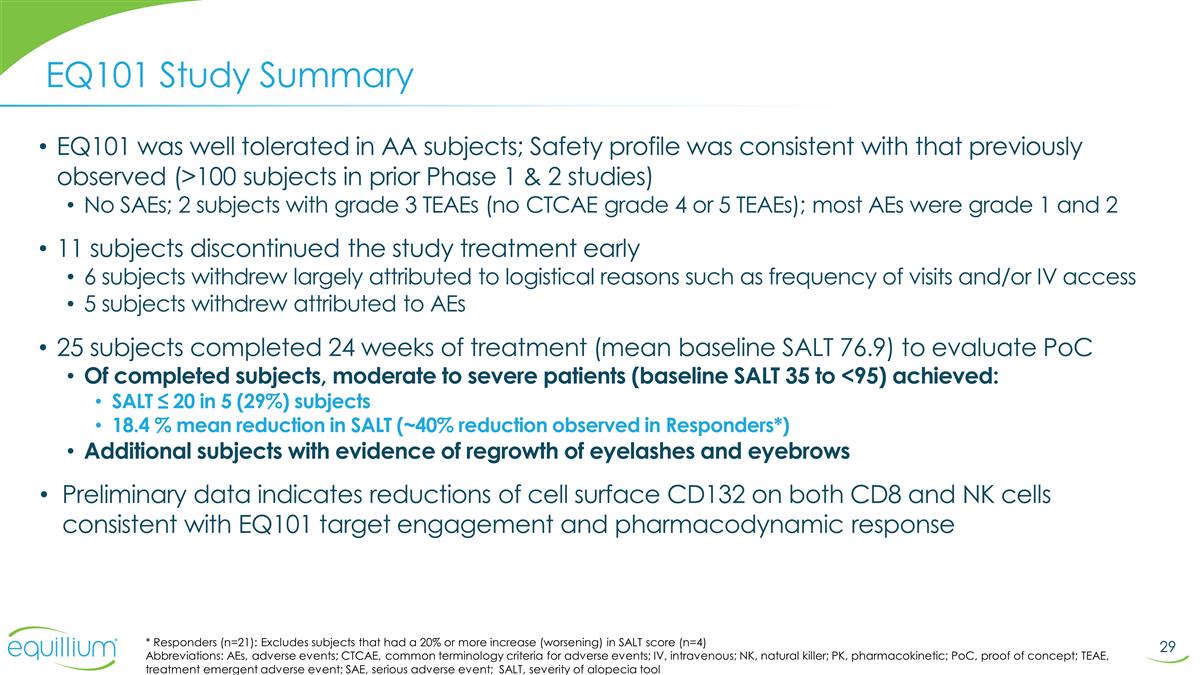
EQ101 Study Summary EQ101 was well tolerated in AA subjects; Safety profile was consistent with that previously observed (>100 subjects in prior Phase 1 & 2 studies) No SAEs; 2 subjects with grade 3 TEAEs (no CTCAE grade 4 or 5 TEAEs); most AEs were grade 1 and 2 11 subjects discontinued the study treatment early 6 subjects withdrew largely attributed to logistical reasons such as frequency of visits and/or IV access 5 subjects withdrew attributed to AEs 25 subjects completed 24 weeks of treatment (mean baseline SALT 76.9) to evaluate PoC Of completed subjects, moderate to severe patients (baseline SALT 35 to <95) achieved: SALT ≤ 20 in 5 (29%) subjects 18.4 % mean reduction in SALT (~40% reduction observed in Responders*) Additional subjects with evidence of regrowth of eyelashes and eyebrows Preliminary data indicates reductions of cell surface CD132 on both CD8 and NK cells consistent with EQ101 target engagement and pharmacodynamic response * Responders (n=21): Excludes subjects that had a 20% or more increase (worsening) in SALT score (n=4) Abbreviations: AEs, adverse events; CTCAE, common terminology criteria for adverse events; IV, intravenous; NK, natural killer; PK, pharmacokinetic; PoC, proof of concept; TEAE, treatment emergent adverse event; SAE, serious adverse event; SALT, severity of alopecia tool
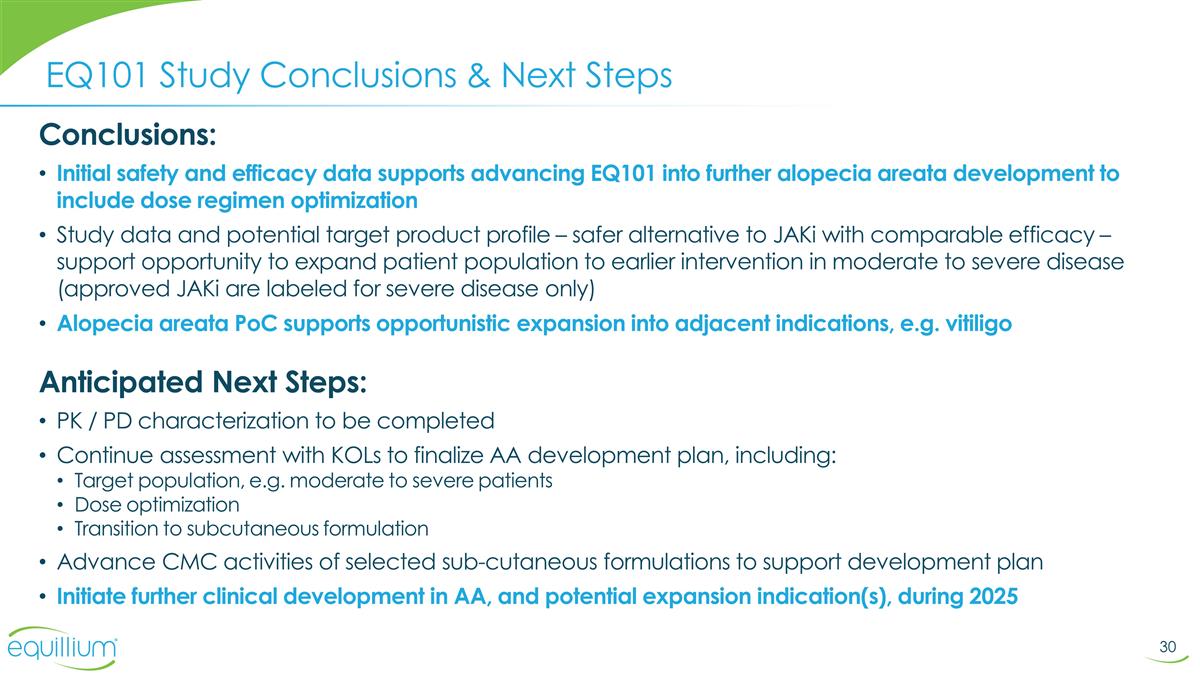
EQ101 Study Conclusions & Next Steps Conclusions: Initial safety and efficacy data supports advancing EQ101 into further alopecia areata development to include dose regimen optimization Study data and potential target product profile – safer alternative to JAKi with comparable efficacy – support opportunity to expand patient population to earlier intervention in moderate to severe disease (approved JAKi are labeled for severe disease only) Alopecia areata PoC supports opportunistic expansion into adjacent indications, e.g. vitiligo Anticipated Next Steps: PK / PD characterization to be completed Continue assessment with KOLs to finalize AA development plan, including: Target population, e.g. moderate to severe patients Dose optimization Transition to subcutaneous formulation Advance CMC activities of selected sub-cutaneous formulations to support development plan Initiate further clinical development in AA, and potential expansion indication(s), during 2025
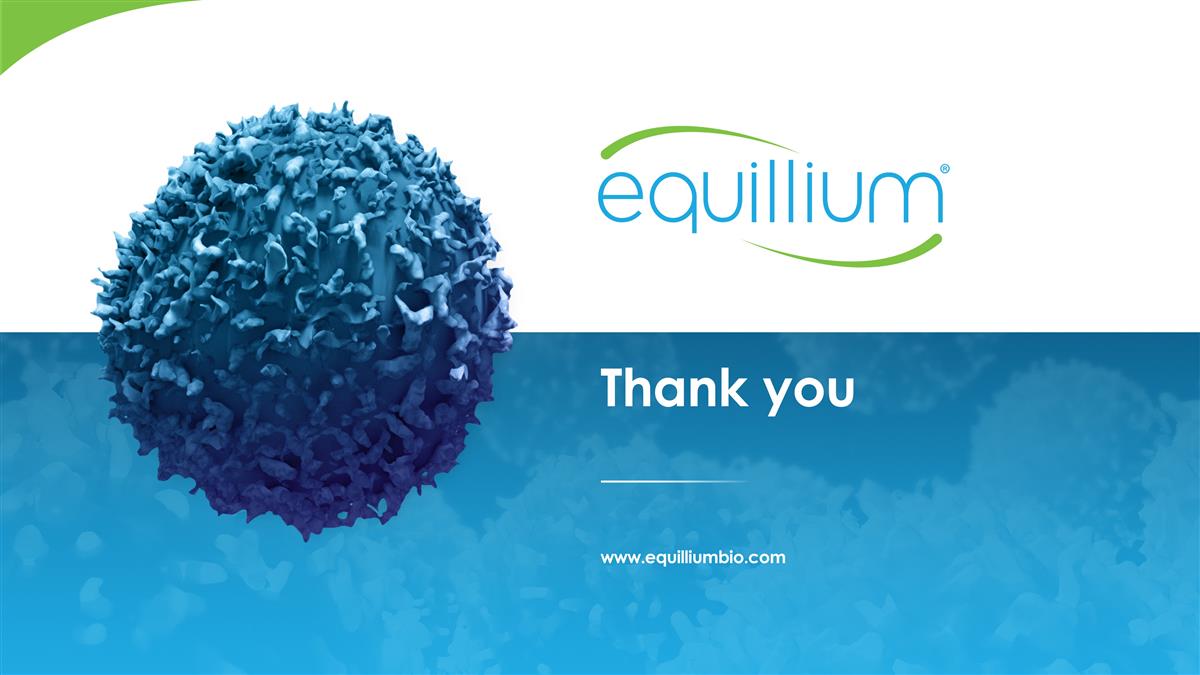
Thank you www.equilliumbio.com






























